
The Book of Kells is an illuminated manuscript and Celtic Gospel book in Latin, containing the four Gospels of the New Testament together with various prefatory texts and tables. It was created in a Columban monastery in either Ireland or Scotland, and may have had contributions from various Columban institutions from each of these areas. It is believed to have been created c. 800 AD. The text of the Gospels is largely drawn from the Vulgate, although it also includes several passages drawn from the earlier versions of the Bible known as the Vetus Latina. It is regarded as a masterwork of Western calligraphy and the pinnacle of Insular illumination. The manuscript takes its name from the Abbey of Kells, County Meath, which was its home for centuries.

Lund Cathedral is a cathedral of the Lutheran Church of Sweden in Lund, Scania, Sweden. It is the seat of the Bishop of Lund and the main church of the Diocese of Lund. It was built as the Catholic cathedral of the archiepiscopal see of all the Nordic countries, dedicated to Saint Lawrence. It is one of the oldest stone buildings still in use in Sweden.
Christiern Pedersen was a Danish canon, humanist scholar, writer, printer and publisher.
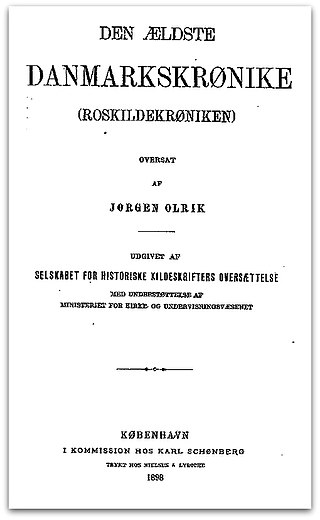
Chronicon Roskildense is a small Danish historical work, written in Latin. It is one of the oldest known attempts to write a coherent account of Danish history by a Danish author, spanning from the introduction of Christianity in Denmark to the author's own time in the middle of the 12th century.
A martyrology is a catalogue or list of martyrs and other saints and beati arranged in the calendar order of their anniversaries or feasts. Local martyrologies record exclusively the custom of a particular Church. Local lists were enriched by names borrowed from neighbouring churches. Consolidation occurred, by the combination of several local martyrologies, with or without borrowings from literary sources.

The Martyrologium Hieronymianum or Martyrologium sancti Hieronymi is an ancient martyrology or list of Christian martyrs in calendar order, one of the most used and influential of the Middle Ages. It is the oldest surviving general or "universal" martyrology, and the precursor of all later Western martyrologies.

Latin translations of the 12th century were spurred by a major search by European scholars for new learning unavailable in western Europe at the time; their search led them to areas of southern Europe, particularly in central Spain and Sicily, which recently had come under Christian rule following their reconquest in the late 11th century. These areas had been under Muslim rule for a considerable time, and still had substantial Arabic-speaking populations to support their search. The combination of this accumulated knowledge and the substantial numbers of Arabic-speaking scholars there made these areas intellectually attractive, as well as culturally and politically accessible to Latin scholars. A typical story is that of Gerard of Cremona, who is said to have made his way to Toledo, well after its reconquest by Christians in 1085, because he:
arrived at a knowledge of each part of [philosophy] according to the study of the Latins, nevertheless, because of his love for the Almagest, which he did not find at all amongst the Latins, he made his way to Toledo, where seeing an abundance of books in Arabic on every subject, and pitying the poverty he had experienced among the Latins concerning these subjects, out of his desire to translate he thoroughly learnt the Arabic language.
The Evangeliary or Book of the Gospels is a liturgical book containing only those portions of the four gospels which are read during Mass or in other public offices of the Church. The corresponding terms in Latin are Evangeliarium and Liber evangeliorum.

Saint Cucuphas is a martyr of Spain. His feast day is 25 July but in some areas it is celebrated on 27 July to avoid conflict with the important feast day of Santiago, the patron saint of Spain. His name is said to be of Phoenician origin with the meaning of "he who jokes, he who likes to joke."
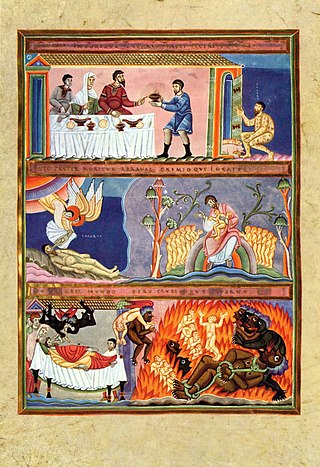
The Codex Aureus of Echternach is an illuminated Gospel Book, created in the approximate period 1030–1050, with a re-used front cover from around the 980s. It is now in the Germanisches Nationalmuseum in Nuremberg.
Henrik Harpestræng was a Danish botanical and medical author. He was a canon at the Roskilde Cathedral. His name literally means harp string. His greatest work was an urtebog, written in Danish. The book consists of 150 chapters dealing with plants and plant parts. The main body of text is probably translations from two Latin works, De viribus herbarum by a person who calls himself Aemilius Macer, but is rather Odo Magdunensis, and De gradibus liber by Constantinus Africanus. However, there are a good many sections of which Henrik Harpestræng is undoubtedly the original author. The book is also an invaluable source for Danish medieval plant names. The best preserved copy of this manuscript dates from the 13th century - now kept in Stockholm.

Dalby Church, sometimes also called the Church of the Holy Cross in Dalby is a church in Dalby, Lund Municipality in the Swedish province of Scania. It is one of the oldest churches in Sweden. When it was built Dalby was part of Denmark, and the church was commissioned by King Sweyn II of Denmark. It was constructed during the second half of the 11th century. For six years, it served as the seat of a bishop, before the diocese was merged with the Diocese of Lund nearby. The church was built with inspiration from Hildesheim Cathedral, and masons from Hildesheim appear to have worked on its construction site.

The Liber Eliensis is a 12th-century English chronicle and history, written in Latin. Composed in three books, it was written at Ely Abbey on the island of Ely in the fenlands of eastern Cambridgeshire. Ely Abbey became the cathedral of a newly formed bishopric in 1109. Traditionally the author of the anonymous work has been given as Richard or Thomas, two monks at Ely, one of whom, Richard, has been identified with an official of the monastery, but some historians hold that neither Richard nor Thomas was the author.
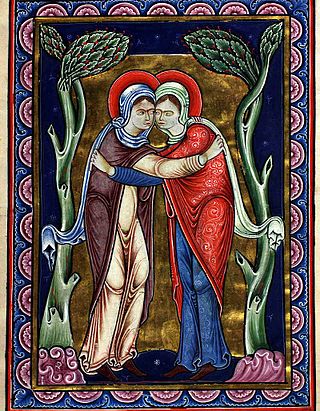
TheCopenhagen Psalter is a 12th-century illuminated manuscript psalter, made in England. It may have been created for the education of the boy king, King Canute VI of Denmark. This manuscript is known for the many artists who contributed to the full-page illuminations. The Copenhagen Psalter is currently in Denmark.
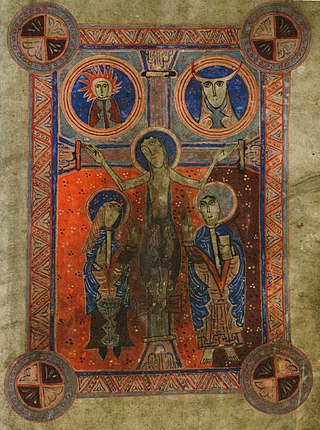
The Skara Missal is a 12th-century illuminated manuscript, a missal kept in Stifts- och landsbiblioteket i Skara, a library in Skara, Sweden. It is the oldest surviving missal of this kind in Scandinavia. It is written in Latin, and is in folio format. Only about one eighth of the original remains, or 44 pages. The book was originally bound in a single volume, but is since the 13th or 14th century split into two volumes. One of the volumes is currently part of the permanent exhibition of Västergötland Museum. It was written by two different scribes. It contains text, illuminations and musical notes. The illuminations consist of two full page illustrations, four large decorative initials and a number of smaller ones. Certain traits indicate that the illuminator may have come from Scandinavia.

Gellone Sacramentary is a late 8th century illuminated manuscript. It is now in the manuscripts department of the Bibliotheque Nationale de France, shelfmark Latin 12048. It is recorded in Saint-Guilhem-le-Désert Abbey at the start of the 9th century. Its style is directly influenced by Merovingian illumination.
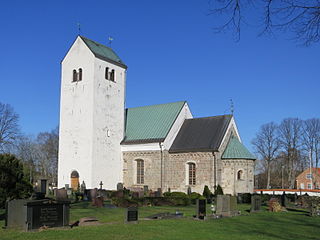
Vä Church, sometimes also called Saint Mary's Church in Vä is a well-preserved Romanesque church in Vä, in the southern Swedish province of Scania. It belongs to the Church of Sweden and is a listed building. It was built in the early 12th century, at a time when Scania was part of Denmark. The building was commissioned by a member of the Danish royal family, probably Queen Margaret Fredkulla. The church originally consisted of a nave, a chancel with an apse and two western towers. Quite soon after being finished, it was donated to Premonstratensian monks who used it as the church of their monastery until 1213. It simultaneously functioned as the parish church of Vä. At the end of the Middle Ages, a third tower was built, and in 1593 the building was enlarged. At the beginning of the 19th century, the western towers were demolished. A major restoration was carried out in the 1960s.

The Emperor's Bible, also known as Codex Caesareus, Codex Caesareus Upsaliensis or the Goslar Gospels, is an 11th-century illuminated manuscript currently in Uppsala University Library, Sweden. Despite its name, it is not a Bible but a Gospel Book. The book was made in the scriptorium of Echternach Abbey, and is one of four preserved large Gospel Books made there during the 11th century. It was commissioned by Emperor Henry III and donated by him to Goslar Cathedral, where it remained until the Thirty Years' War. It was then lost for about 100 years. Its previous richly decorated cover was also lost at this time at the latest. The book later appeared again in the possession of Swedish diplomat and civil servant Gustaf Celsing the Elder. At the death of his son, it was acquired by Uppsala University.

Necrologium Lundense is a 12th-century illuminated manuscript probably made in Lund to serve as a book of rules for the canons of Lund Cathedral, with texts used by them in their daily life. Its oldest parts date from around 1123, and it is considered the oldest still intact manuscript written in Scandinavia. It is preserved in a late medieval binding and the text is partially adorned with decorated initials, including one which displays influences from Viking art. The book is today kept in the University Library of Lund University.

The Dalby Gospel Book is an 11th-century gospel book currently in the Royal Library of Denmark in Copenhagen. The illuminated manuscript derives its name from Dalby Church in Sweden, where the gospel book was used. During the Middle Ages, Dalby was part of Denmark. It is not known with certainty where the book was made; several researchers have suggested it was made in Dalby, while others point to present-day Germany as a probable place of origin. The manuscript is the earliest testimony of the presence of books and a culture of literacy in Denmark. The book contains four full-page miniatures with portraits of the Four Evangelists, 16 canon tables and a number of simple, red enlarged initials. Its gilt silver and copper binding is from the middle of the 12th century.
















